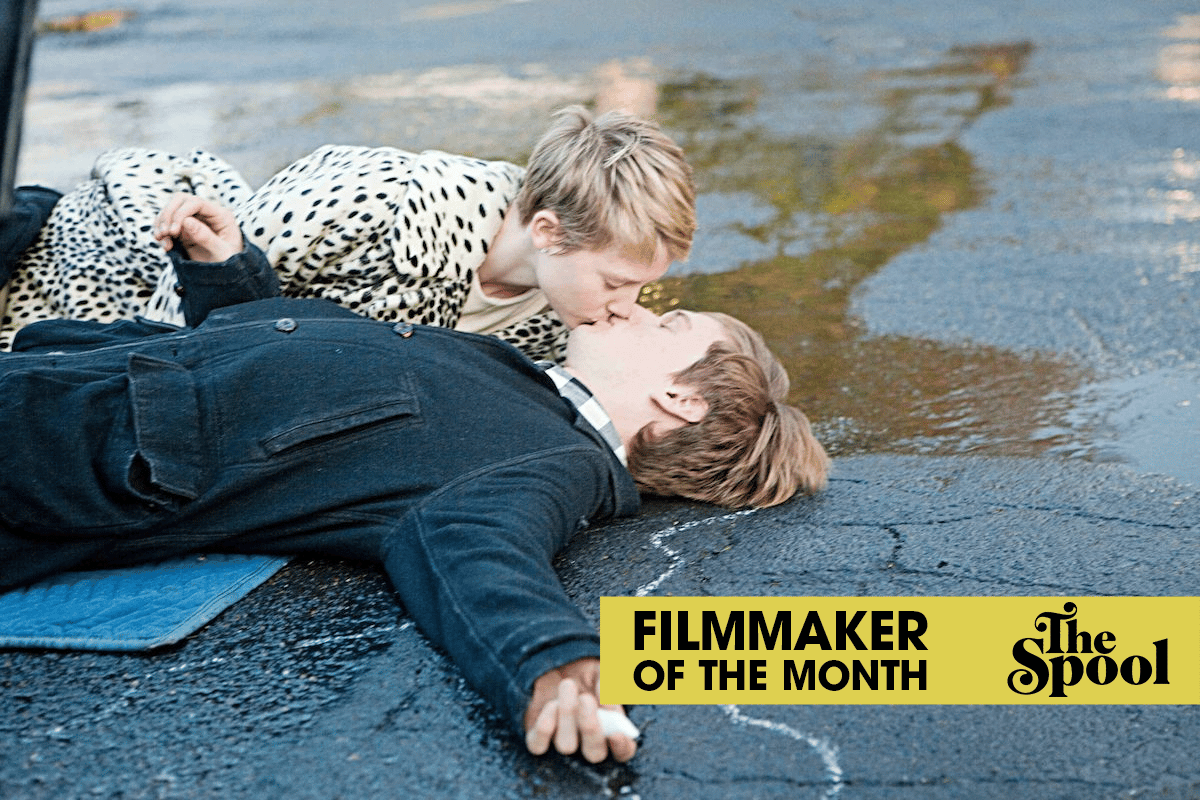Every month, we at The Spool select a filmmaker to explore in greater depth — their themes, their deeper concerns, how their works chart the history of cinema and the filmmaker’s own biography. For June, we celebrate the birthday (and the sensitive, insightful eye) of Gus Van Sant. Read the rest of our coverage here.
On January 25, 2007, writer Nathan Rabin coined a nifty bit of pop-culture terminology: “the Manic Pixie Dream Girl.” Used therein to describe Kirsten Dunst’s character from Cameron Crowe’s Elizabethtown—a flight attendant who cures Orlando Bloom’s sadness through, like, a magical mixtape or something—Rabin defines the trope as a character that “exists solely… to teach broodingly soulful young men to embrace life and its infinite mysteries and adventures.” More importantly, the Manic Pixie Dream Girl serves as something of a litmus test for the viewer. She is, as Rabin puts it, “an all-or-nothing proposition. Audiences either want to marry her instantly… or they want to commit grievous bodily harm against them and their immediate family.”
Whether he realized it or not, Rabin was tapping into the zeitgeist. The first decade of the 21st century was the Golden Age of the Manic Pixie Dream Girl. In addition to Dunst, we had Natalie Portman’s Shins-loving narcoleptic in Garden State, Kate Winslet’s electric blue-haired potato artist in Eternal Sunshine of the Spotless Mind, and basically Zooey Deschanel’s entire filmography.
However, nearly five years after Rabin’s article, a film would come along that would essentially kill off the Manic Pixie Dream Girl, both figuratively and literally. A film so nauseatingly cutesy, so cloyingly whimsical, and so oppressively twee that it makes Elizabethtown look like Sátántangó. That film is Restless, and it answers the question, What happens when a Manic Pixie Dream Girl meets a Manic Pixie Dream Boy? Nothing you’d want to watch for 97 minutes, that’s for damn sure.

Restless’ journey to the screen began, like all things insufferable do, at NYU drama school. Originally written as a play by Jason Lew, his friend and classmate Bryce Dallas Howard encouraged him to develop the story into a film. In a move that should encourage you to write to your congressperson and demand that they pass some sort of anti-nepotism legislation, she then convinced her father, Ron Howard, and his producing partner, Brian Grazer, to set the film up at their production company. Before long, she was co-producing the movie for Imagine Entertainment alongside them.
Originally, Ron Howard wanted to direct the film as well, but scheduling conflicts made that impossible. (If there’s one silver lining to this whole ordeal, at least we were spared Ron Howard’s mayonnaise-tinted take on this material.) Lew and Bryce Dallas Howard’s second choice was Gus Van Sant, who signed on to direct immediately after reading Lew’s screenplay.
Look, for as dreadful as Lew’s screenplay is, I can understand how a director like Van Sant would see some appeal in this story. After all, he made a name for himself crafting whimsical yarns about the outcasts of society, and Restless certainly is that. The problem is, back in the glory days of American independent film, Van Sant’s outcasts had some bite to them. They felt dangerous. Just look at the crew of heroin-addled petty thieves in Drugstore Cowboy or the young gay hustlers prowling the dark Portland streets in My Own Private Idaho. There’s none of that danger in the protagonists of Restless. This pair of navel-gazing shits is more like the sort of outcasts you dread being trapped in conversation with at parties.

Lucky for us, they in turn would probably pass up that party for a good ol’ fashioned funeral. See, our Manic Pixie Dream Boy, Enoch (Henry Hopper, son of Dennis, speaking of nepotism), has been obsessed with death ever since his parents were killed in a car crash that left him comatose for three months. Now he passes the time by dressing like an indie rock Arthur Rimbaud, drawing his own outline in chalk on the pavement, and crashing the strangers’ funerals. Oh, and he plays Battleship with his only friend, who is… no, wait, I’m not ready to get to that just yet.
At one such funeral, he meets a fellow crasher and our Manic Pixie Dream Girl, Annabel (Mia Wasikowska). Lucky for Enoch, Annabel’s personality is made up of similarly insufferable quirks: she dresses like a thrift store Jean Seberg, pens photorealistic drawings of birds and beetles in her spare time, and speaks fawningly to a poster of Charles Darwin. But most importantly, she shows a positively Saint-like grace towards Enoch’s dark boy bullshit. She’s totally fine with carrying on a conversation aimed at his parents’ headstone. She’s totally down to make up goofy names for the stiffs down at the morgue. She doesn’t even bat an eye when Enoch tells her that his only friend is… yeah, no, I still can’t bring myself to go there.
From that morbid meet-cute grows a friendship, and that friendship soon blooms into romance. But then, in a twist you probably saw coming if you noticed her predilection for old timey hats, Annabel reveals to Enoch that she is suffering from the Manic Pixie Dream Girl’s one weakness: terminal cancer. Will she live long enough to teach Enoch some powerful lessons about how to let go of the past? How about getting him to come back to the world of the living and appreciate the good memories that live on with him? Maybe, just maybe, the reason Enoch is trapped in an endless cycle of grief is that “death is easy. It is love that is hard.”

That line comes from Enoch’s only friend, who is… okay, here goes… the ghost of a World War II kamikaze pilot named Hiroshi (Ryô Kase). Yes, you read that right: the ghost of a World War II kamikaze pilot named Hiroshi.
I don’t really know what else to say about Hiroshi. His purpose in the story is nebulous at best. Ultimately, it feels like Hiroshi is there simply because the very idea of the main character’s only friend being the ghost of a World War II kamikaze pilot named Hiroshi is “quirky.” He’s not there to teach our lovebirds about cultural appropriation: during the film’s Halloween sequence, not only does Enoch dress up like Hiroshi, complete with X’s over his eyes, but Annabel dresses up like a geisha.
It certainly doesn’t help the film that Enoch and Annabel are just the worst, yellowface Halloween costumes included. They’re so myopic and childish that you pray for some other character to call them out on their bullshit, but the closest we get is Annabel’s protective older sister Lizzie (Schuyler Fisk) occasionally giving Enoch side-eye. Instead, everyone either tolerates them or finds them utterly charming, making me the viewer feel like I’m being gaslighted. Fun!
Because she’s the most manic, pixiest, and dreamiest of all the Manic Pixie Dream Girls—not to mention the most bright eyed and rosy-cheeked terminally ill person in cinema history—Annabel treats her imminent demise with a quirky smile and a cheery shrug, which of course sets Enoch off on a nervous breakdown. It begins with them seeming to break up while rehearsing an emotionally overwrought one-act play they wrote about her death (which, come on).

Before long, Enoch is screaming at Annabel’s doctor (Chin Han) to “make her better” and finally smashing his parents’ headstone with a sledgehammer while hollering up to the heavens, “I hate yooooou!” Unfortunately, because young Mr. Hopper has a terminal lack of anything even resembling charisma or pathos, this all comes across as gut-bustlingly hilarious. Instead of being heartbreaking, it’s whiny.
Ultimately, all that Restless amounts to is a collection of twee tropes straining for profundity and poignancy, failing miserably to achieve either. Everything here has been done before in much better films. Harold and Maude at least gave its male protagonist’s fixation on death some panache and humor. The early work of Wes Anderson, which Restless stylistically apes a number of times to the point of ripping off a Royal Tenenbaums needle drop, at least had some originality for its time and context. Why Van Sant devoted nearly a year of his life to helping some well-connected theater kids recreate a bunch of films they only understood in the most surface-level ways is beyond me.
Why Van Sant devoted nearly a year of his life to helping some well-connected theater kids recreate a bunch of films they only understood in the most surface-level ways is beyond me.
This marks the beginning of a rough, steady decline for Van Sant. Following the artistic triumph of the “Death Trilogy” and the Oscar-winning success of Milk, he made a series of films that were instantly forgotten. That fate befell Restless, as well as its follow-up, the painfully dull agricultural drama Promised Land. The notorious Sea of Trees, which was brutally mocked at its Cannes premiere, later ended up barely getting a release. Then there’s the cartoonish and misguided Don’t Worry, He Won’t Get Far on Foot. Today, if there’s one film in Van Sant’s whole oeuvre that no one seems to remember, it’s Restless. If I were him, I’d take that as something of a relief.
After the non-response afforded to it, it seems as though the era of the Manic Pixie Dream Girl came to its conclusion. The inoffensive arthouse fare of early 2000s indie powerhouses like Focus Features and Sony Pictures Classics was replaced by the more edgy, youth-oriented films favored by the likes of Annapurna and A24.
To watch Restless today is to watch a moment frozen in time. Two skinny white kids, both of whom look like they escaped from a Belle & Sebastian album cover, wander through an autumnal cityscape. They fall in love to the strains of some Sufjan Stevens ballads. They take solace in each other’s fashionably twee oddness. And it all goes on for over an hour and a half. But, like a Manic Pixie Dream Girl struck down by some ill-defined cancer, some tropes just need to die and stay dead.

